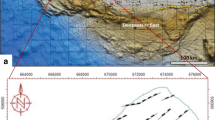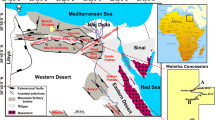In order to understand the problem of sediment sources in the Xujiahe Formation of the Central Sichuan Uplift, high-density two-dimensional seismic data was used, and LCS2 (the second section of the Xujiahe Formation) was taken as the research object. Combined with logging interpretation results, typical seismic facies were identified within the sequence, including clinoform seismic facies, progradational reflection seismic facies, and incised valley seismic facies. The progradational reflection seismic facies can be divided into two types: S-shaped and oblique progradational reflection facies. The oblique progradational reflection seismic facies representing the rapid filling environment of sediments are mainly distributed in the southeast of the study area, while the northwest mainly develops relatively low-energy sedimentary mechanisms of S-shaped seismic facies. The incised valley seismic facies are mainly distributed in the eastern and southeastern parts of the work area. On the plane, the incised valley seismic facies have a trend of gradually widening and shallowing towards the northwest direction. In addition, the distribution of sedimentary facies was analyzed using seismic attributes. The southeastern and central parts of the study area are mainly composed of proximal sand-rich braided river alluvial plains, while the northwestern part is mainly composed of distal mud-rich braided river alluvial plains. The distribution of sedimentary facies generally shows a southwest to northeast distribution. From southeast to northwest, the sedimentary facies show a clear trend of changing from sand-rich to mud-rich. Based on the comprehensive distribution characteristics of seismic and sedimentary facies, it is believed that the river in the Central Sichuan Uplift basically enter the region from the south or southeast, and transport sediments from southeast to northwest. Based on the above evidence, it is inferred that the sedimentary material of the Xujiahe Formation in the Central Sichuan Uplift mainly comes from the «Qianzhong Ancient Uplift» or «Fanjing Mountain Ancient Land» on the southern and southeastern of the Sichuan Basin.





Similar content being viewed by others
References
Zhang, G., Zhi, W.Z., Yang, Y., et al. Resource evaluation, position and distribution of tight sandstone gas in China. Engineering Sciences, 2012, 4, 87-93.
Yu, Y., Lin, L., Zhai, C., et al. Diagenesis and reservoir characteristics analysis of the Late Triassic Xujiahe Formation tight gas sandstone in the northern Sichuan Basin, China. Energy Exploration & Exploitation, 2017, 36(4), 743-763.
Cao, L., Wang, X., Li, Q. Petroleum system and exploration prospect of Xujiahe formation in ziyang area, central Sichuan Basin. Natural Gas Exploration & Development, 2012, 35, 1-5.
Xue, G.Q., Li, Z.Y., Guo, W.B., et al. The exploration of sedimentary bauxite deposits using the reflection seismic method: A case study from the Henan Province, China. Ore Geology Reviews, 2020, 127, 103832.
Zhang, Y. L., Jia, X.T., Wang, K.M., et al. Provenance analysis of Triassic sediments in the Yingjing area on the western margin of the Yangtze Craton. Geological Review, 2021, 67(03), 625-639.
Dai, C.C., Zheng, R.C., Ren, J.P., et al. Provenance analysis of Xujiahe Foramtin of Upper Triassic in Sichuan foreland basin and its geology implications. Journal of Jilin University: Earth Science Edition, 2014, 44, 1085-1096.
Chen, S.L., Luo, S.S., Zhang, S.F., et al. Discovery of Microbial Mounds and Its Geological Significance. Chem Technol Fuels Oils, 2023, 59, 1112-1120.
Zhu R.K., Zhao, X., Liu, L.H., et al. Depositional system and favorable reservoir distribution of Xujiahe Formation in Sichuan Basin. Petroleum Exploration & Development, 2009, 36(01), 46-55.
Liu, H., Peng, J., Li, L.J., et al. Characteristics and provenance analysis of the Upper Tertiary Xujiahe Formation sandstone in the middle part of West Sichuan depression. Geology in China, 2012, 39, 1271-1279.
Shi, Z., Wang, X., Wu, C. The heavy minerals and provenances of the upper Triassic Xujiahe Formation in Sichuan Basin. Natural Gas Geoscience, 2011, 22, 618-627.
Burg, M.J., Winkler, W., Ruh, J., et al. Detrital zircon and provenance analysis of Late Cretaceous-Mioceneonshore Iranian Makran strata: Implications for the tectonic setting. GSA Bullet, 2016, 128, 1481-1499.
Petersen, T.G., Thomsen, T.B., Olaussen, S., et al. Provenance shifts in an evolving Eurekan foreland basin: the Tertiary Central Basin, Spitsbergen. Journal of the Geological Society, 2016, 173, 634-648.
Eynatten, H.V., & Dunkl, I. Assessing the sediment factory: The role of single grain analysis. Earth-Science Reviews, 2012, 115, 97-120.
Chen, X.E., Fan, K., Xiong, Y., et al. Seismic Sequence Research and Provenance Analysis of the Upper Triassic Xujiahe Formation in AY area, Central Sichuan Basin. Lithologic Reservoirs, 2014, 26, 45-51.
Dai, C.C. Study on Sequence Filling Patterns and Reservoir Distribution of the Xujiahe Formation in Sichuan Foreland Basin. Chengdu: Chengdu University of Technology (Thesis), 2011. 45-52.
Zhu, H., Yang, X., Liu, K. Seismic-based sediment provenance analysis in continental lacustrine rift Basins: an example from the Bohai Bay Basin, China. AAPG Bulletin, 2014, 98, 1995-2018.
Zheng, R.C., Li, G.H., Dai, C.C., et al. Basin-Mountain coupling system and its sedimentary response in Sichuan analogous foreland basin. Acta Geologica Sinica, 2012, 86, 170-180.
Zhao, Z.W., Xie, J.R., Wu, C.J., et al. Petroleum system and exploration prospect of Xujiahe Formation in Ziyang area, Central Sichuan. Natural Gas Exploration and Development, 2012, 35(04), 6-11.
Su, J.L., Lin, L.B., Yu, Y. Comparative Study on the Provenance and Reservoir Characteristics of the Second and Fourth Members of the Upper Triassic Xujiahe Formation in the Xinchang Area, Western Sichuan, China. Acta Sedimentolgical Sinica, 2023, 41(05), 1451-1467.
Xu, C., Gehenn, J.M., Zhao, D., et al. The fluvial and lacustrine sedimentary systems and stratigraphic correlation in the upper Triassic Xujiahe Formation in Sichuan Basin, China. AAPG Bulletin, 2015, 99, 2023-2041.
Zhang, L., Guo, X., Hao, F., et al. Lithologic characteristics and diagenesis of the Upper Triassic Xujiahe Formation, Yuanba area, northeastern Sichuan Basin. Journal of Natural Gas Science and Engineering, 2016, 35, 1320-1313.
Wang, X.J., Zheng, C.R., Li, S., et al. Stratigraphic subdivision and correlation of the early Triassic Xujiahe Formation, east Sichuan Basin: A case study of the Woxinshuang area. Journal of Stratigraphy, 2017, 41(01), 94-102.
Zheng, R.C., Dai, C.C., Ru, R.K., et al. Sequence- based lithofacies and paleogeographic characteristics of Upper Triassic Xujiahe Formation in Sichuan Basin. Geological Review, 2009, 55, 484-495.
Tang, Y., Wang, J.J., Cui, Z.H. An analysis of the gas source in the Upper Triassic Xujiahe Formation, central Sichuan Basin. Geological Bulletin of China, 2011, 30, 1608-1613.
Liu, Y., Qiu, N.S., Xie, Z.Y., et al. Overpressure compartments in the central paleo-uplift, Sichuan Basin, southwest China: AAPG Bulletin, 2016, 100, 867-888.
Xu, G., & Haq, B.U. Seismic facies analysis: Past, present and future. Earth-Science Reviews, 2022, 224, 103876.
Patruno, S., Hampson, G.J., & Jackson, C. Quantitative characterization of deltaic and subaqueous clinoforms. Earth-Science Reviews, 2015, 142, 79-119.
Pellegrini, C., Patruno, S., Helland-Hansen, W., et al. Clinoforms and clinothems: Fundamental elements of basin infill. Basin Research, 2020, 32(2), 187-205.
Lin, C., He, M., Steel, R.J. et al. Changes in inner- to outer-shelf delta architecture, Oligocene to Quaternary Pearl River shelf-margin prism, northern South China Sea. Marine Geology, 2018, 404, 187-204.
Feng, C., Sun, M., Liu, C., et al. Seismic sedimentary characteristics and filling structure of the Upper Triassic Yanchang Formation, Ordos Basin, China. Interpretation, 2020, 1-46.
Deibert, J.E., & Camilleri, P.A. Sedimentologic and tectonic origin of an incised-valley-fill sequence along an extensional marginal-lacustrine system in the Basin and Range province, United States: Implications for predictive models of the location of incised valleys. AAPG Bulletin, 2006, 90(2), 209-235.
Wang, R., Colombera, L., & Mountney, N.P. Quantitative analysis of the stratigraphic architecture of incised-valley fills: A global comparison of Quaternary systems. Earth-Science Reviews, 2020, 200, 102988.
Satinder C., Marfurt, K.J. Seismic Attributes for Prospect Identification and Reservoir Characterization. Society of Exploration, 2007, 48-54.
Herrero-Barbero, P., Álvarez-Gómez, J., Tsige, M., et al. Deterministic seismic hazard analysis from physics-based earthquake simulations in the Eastern Betics (SE Iberia). Engineering Geology, 2023, 237, 107364.
Wang, X.J., Wang, C.Y., Chen, X.E., et al. Stratigraphic Correlation of the Upper Triassic and Its Sedimentary Filling Characteristics in the Western and Central Sichuan Basin. Acta Geological Sinica, 2023, 41(02), 435-449.
Author information
Authors and Affiliations
Corresponding author
Additional information
Translated from Khimiya i Tekhnologiya Topliv i Masel, No. 2, pp. 173–178, March– April, 2024.
Rights and permissions
Springer Nature or its licensor (e.g. a society or other partner) holds exclusive rights to this article under a publishing agreement with the author(s) or other rightsholder(s); author self-archiving of the accepted manuscript version of this article is solely governed by the terms of such publishing agreement and applicable law.
About this article
Cite this article
Chen, X., Fan, K., Wang, C. et al. Seismic Sequence and Source Analysis of Typical Sandstone Reservoirs. Chem Technol Fuels Oils 60, 461–470 (2024). https://doi.org/10.1007/s10553-024-01700-2
Published:
Issue Date:
DOI: https://doi.org/10.1007/s10553-024-01700-2




